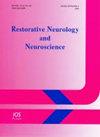冲击波调节皮质脊髓兴奋性:用于进一步康复的概念证明?
IF 1.6
4区 医学
Q4 NEUROSCIENCES
引用次数: 0
摘要
背景:病灶体外冲击波疗法(fESWT)是一种物理疗法,已被广泛研究并用于治疗各种肌肉骨骼疾病。然而,体外冲击波疗法对中枢神经系统的影响仍有待确定。目的:在健康受试者中阐明脊柱和脊柱上的 fESWT 机制,以拓宽其临床应用范围。方法:在这项准实验性、非盲法、概念验证临床研究中,10 名自愿的健康受试者接受了 fESWT,并在干预前(T0)、干预后(T1)和干预后七天(T2)分别进行了评估。作为神经生理学结果,运动诱发电位(静息运动阈值、最大运动诱发电位和最大复合肌肉动作电位比值、皮质沉默期、总传导运动时间、直接和间接中枢运动传导时间)、F波(最小和平均潜伏期、持续性和时间弥散性)和H反射(阈值、振幅、最大H反射和最大复合肌肉动作电位比值、潜伏期)均被纳入考虑范围。结果:静息运动阈值和 F 波时间弥散分别从 T1 到 T2 和从 T0 到 T2 显著下降(均为 p <0.05)。H反射阈值在T0和T1之间上升。分析表明,Δ3皮质沉默期(即T2 -T1记录)与Δ1 Hr阈值(即T1 -T0记录)之间呈强负相关(r = -0.66,p < 0.05),而Δ3皮质沉默期与Δ3 Hr阈值之间呈强正相关(r = 0.63,p < 0.05)。结论:fESWT可调节健康志愿者的皮质脊髓束兴奋性,可能会诱导早期抑制,一周后再诱导后期促进。本文章由计算机程序翻译,如有差异,请以英文原文为准。
Shock waves modulate corticospinal excitability: A proof of concept for further rehabilitation purposes?
Background:Focal extracorporeal shock wave therapy (fESWT) is a physical therapy vastly studied and used for various musculoskeletal disorders. However, the effect of fESWT on central nervous system is still to be determined. Objective:To elucidate spinal and supra-spinal mechanisms of fESWT in healthy subjects, in order to widen the spectrum of its clinical applications. Methods:In this quasi-experimental, unblinded, proof-of-concept clinical study, 10 voluntary healthy subjects underwent fESWT and were assessed immediately before (T0), immediately after (T1) and seven days after (T2) the intervention. As neurophysiological outcomes, motor evoked potentials (resting motor threshold, maximal motor evoked potential and maximal compound muscle action potential ratio, cortical silent period, total conduction motor time, direct and indirect central motor conduction time), F-waves (minimal and mean latency, persistence and temporal dispersion) and H-reflex (threshold, amplitude, maximal H reflex and maximal compound muscle action potential ratio, latency) were considered. Results:Resting motor threshold and F-waves temporal dispersion significantly decreased, respectively, from T1 and T2 and from T0 and T2 (for both, p < 0.05). H-reflex threshold increase between T0 and T1. Analysis disclosed a strong negative correlation between Δ3 cortical silent period (i.e., T2 –T1 recordings) and Δ1 Hr threshold (i.e., T1 –T0 recordings) (r = –0.66, p < 0.05), and a positive strong relationship between Δ3 cortical silent period and Δ3 Hr threshold (r = 0.63, p < 0.05). Conclusions:fESWT modulates corticospinal tract excitability in healthy volunteers, possibly inducing an early inhibition followed by a later facilitation after one week.
求助全文
通过发布文献求助,成功后即可免费获取论文全文。
去求助
来源期刊
CiteScore
5.40
自引率
3.60%
发文量
22
审稿时长
>12 weeks
期刊介绍:
This interdisciplinary journal publishes papers relating to the plasticity and response of the nervous system to accidental or experimental injuries and their interventions, transplantation, neurodegenerative disorders and experimental strategies to improve regeneration or functional recovery and rehabilitation. Experimental and clinical research papers adopting fresh conceptual approaches are encouraged. The overriding criteria for publication are novelty, significant experimental or clinical relevance and interest to a multidisciplinary audience. Experiments on un-anesthetized animals should conform with the standards for the use of laboratory animals as established by the Institute of Laboratory Animal Resources, US National Academy of Sciences. Experiments in which paralytic agents are used must be justified. Patient identity should be concealed. All manuscripts are sent out for blind peer review to editorial board members or outside reviewers. Restorative Neurology and Neuroscience is a member of Neuroscience Peer Review Consortium.

 求助内容:
求助内容: 应助结果提醒方式:
应助结果提醒方式:


